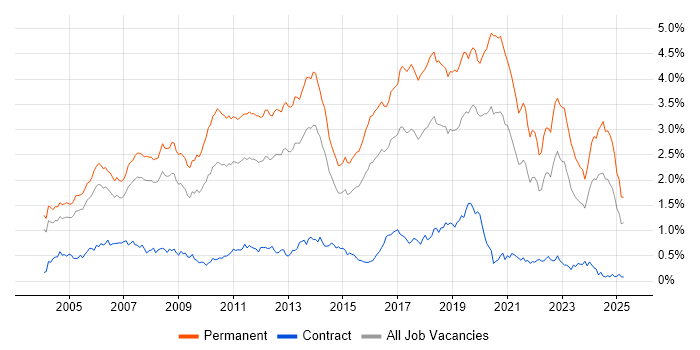Software Developer
South East > Thames Valley
The median Software Developer salary in the Thames Valley is £70,000 per year, according to job vacancies posted during the 6 months leading to 12 December 2025.
The table below compares current salary benchmarking and summary statistics with the previous two years.
| 6 months to 12 Dec 2025 |
Same period 2024 | Same period 2023 | |
|---|---|---|---|
| Rank | 130 | 68 | 108 |
| Rank change year-on-year | -62 | +40 | -23 |
| Permanent jobs requiring a Software Developer | 49 | 144 | 70 |
| As % of all permanent jobs in the Thames Valley | 1.28% | 3.64% | 2.14% |
| As % of the Job Titles category | 1.39% | 3.96% | 2.27% |
| Number of salaries quoted | 46 | 109 | 66 |
| 10th Percentile | £46,875 | £45,000 | £45,500 |
| 25th Percentile | £50,000 | £47,500 | £52,500 |
| Median annual salary (50th Percentile) | £70,000 | £65,000 | £70,000 |
| Median % change year-on-year | +7.69% | -7.14% | +47.37% |
| 75th Percentile | £80,000 | £75,000 | £82,500 |
| 90th Percentile | £85,000 | £81,000 | £95,000 |
| South East median annual salary | £60,000 | £60,000 | £55,000 |
| % change year-on-year | - | +9.09% | +4.76% |
All Permanent IT Job Vacancies
Thames Valley
For comparison with the information above, the following table provides summary statistics for all permanent IT job vacancies in the Thames Valley. Most job vacancies include a discernible job title that can be normalized. As such, the figures in the second row provide an indication of the number of permanent jobs in our overall sample.
| Permanent vacancies in the Thames Valley with a recognized job title | 3,513 | 3,634 | 3,078 |
| % of permanent jobs with a recognized job title | 91.96% | 91.91% | 94.10% |
| Number of salaries quoted | 1,998 | 1,893 | 2,260 |
| 10th Percentile | £29,000 | £32,500 | £31,250 |
| 25th Percentile | £35,000 | £41,263 | £38,750 |
| Median annual salary (50th Percentile) | £47,500 | £57,500 | £54,250 |
| Median % change year-on-year | -17.39% | +5.99% | -1.36% |
| 75th Percentile | £65,000 | £74,000 | £68,750 |
| 90th Percentile | £80,000 | £87,500 | £83,750 |
| South East median annual salary | £50,000 | £55,000 | £52,500 |
| % change year-on-year | -9.09% | +4.76% | -4.55% |
Software Developer
Job Vacancy Trend in the Thames Valley
Historical trend showing the proportion of permanent IT job postings featuring 'Software Developer' in the job title relative to all permanent IT jobs advertised in the Thames Valley.

Software Developer
Salary Trend in the Thames Valley
Salary distribution trend for Software Developer job vacancies in the Thames Valley.

Software Developer
Salary Histogram in the Thames Valley
Salary distribution for jobs citing Software Developer in the Thames Valley over the 6 months to 12 December 2025.
Software Developer
Job Locations in the Thames Valley
The table below looks at the demand and provides a guide to the median salaries quoted in IT jobs citing Software Developer within the Thames Valley region over the 6 months to 12 December 2025. The 'Rank Change' column provides an indication of the change in demand within each location based on the same 6 month period last year.
| Location | Rank Change on Same Period Last Year |
Matching Permanent IT Job Ads |
Median Salary Past 6 Months |
Median Salary % Change on Same Period Last Year |
Live Jobs |
|---|---|---|---|---|---|
| Berkshire | -57 | 25 | £80,000 | +14.29% | 16 |
| Oxfordshire | +8 | 13 | £67,500 | +50.00% | 9 |
| Buckinghamshire | +19 | 11 | £50,000 | - | 9 |
| Software Developer South East |
|||||
Software Developer Skill Set
Top 30 Co-Occurring Skills & Capabilities in the Thames Valley
For the 6 months to 12 December 2025, Software Developer job roles required the following skills and capabilities in order of popularity. The figures indicate the absolute number of co-occurrences and as a proportion of all permanent job ads across the Thames Valley region featuring Software Developer in the job title.
|
|
Software Developer Skill Set
Co-Occurring Skills & Capabilities in the Thames Valley by Category
The following tables expand on the one above by listing co-occurrences grouped by category. They cover the same employment type, locality and period, with up to 20 co-occurrences shown in each category:
